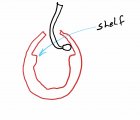I've been learning to turn hollow forms in the past six months or so and am getting better with each one. I'm still not able to smooth and finish the interiors to my satisfaction. How much effort and priority do you put on the interiors of hollow forms and what tools and techniques do you use to smooth and sand them?
Many thanks for your help.
Many thanks for your help.

